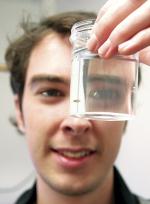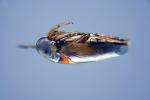Diving insect regulates buoyancy: world first
 Physiology Physiology
A University of Adelaide PhD physiology researcher has discovered a world first: a diving insect that can regulate its buoyancy in water, just like a scuba diver. The findings of Phil Matthews, 24, in relation to the backswimmer (Anisops deanei), were published in the prestigious international science journal, Nature, last month. Considered the bible by scientists the world over, publication in the weekly journal guarantees instant respect from academic peers around the globe. Yet, when Mr Matthews submitted the findings of his research in January, he was convinced "it would trickle down the tree and get buried under hundreds of other submissions". Instead, his paper was accepted by Nature and published on 9 May, immeasurably boosting the young physiologist's career prospects on an international scale. The paper discusses a significant finding in the physiology world relating to the backswimmer. It appears that these bugs use haemoglobin-containing cells in their abdomen to supply oxygen and regulate their buoyancy, a quirk of nature unique to backswimmers. It allows these insects to remain poised in the water for around four minutes without having to surface for oxygen - something that no other insect in the world can do. Mr Matthews and his PhD supervisor, Professor Roger Seymour from Environmental Biology, made the discovery by placing a submerged backswimmer on a sensitive weight balance and measuring the oxygen level inside its bubble. Foraging insects sport an over-inflated bubble filled with nitrogen and oxygen when embarking on a dive, but the effort of dragging this buoyant cargo downwards through the water quickly uses up oxygen. "Carrying a bubble when you are a tiny insect means you are going to be very buoyant. If you are not clinging to the bottom, or swimming very hard to stay submerged, you are going to be shooting straight to the surface," Mr Matthews explained. "A bubble of air carried by a diving insect is always going to be shrinking. About 20% of the bubble's volume is oxygen, so as the insect respires the oxygen the bubble will inevitably shrink. "Simultaneously, nitrogen in the bubble dissolves into the water, further shrinking the bubble. Without a stable bubble volume a stable buoyancy cannot be achieved." Backswimmers overcome these problems by carrying extra oxygen reserves in their haemoglobin, stored in their abdomen. It means they can carry a much smaller bubble, and by releasing oxygen from the haemoglobin into the bubble, can regulate its volume to stop it shrinking. "This buoyancy system is unique amongst all creatures," Mr Matthews said. "This finding shows that evolution can produce the most unexpected solutions to a problem, in this case using haemoglobin in an entirely unique way." On a human level, the back-swimmers replicate the same effect as a scuba diver's buoyancy vest, which allows them to hover weightless in the water. "Like many of the best inventions, the animal kingdom got there first," Mr Matthews said. He said entomologists had been aware of the correlation between haemoglobin and neutral buoyancy in backswimmers since the early 1900s, but this was the first successful experiment to directly measure the buoyancy and oxygen levels. Story by Candy Gibson
|





